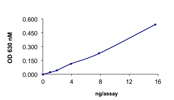
PTPN11 (T253M Q257L), Active(P38-22G)
FOR BULK ORDER REQUESTS PLEASE CONTACT US
Description :Recombinant full-length human PTPN11 (T253M Q257L) was expressed by baculovirus in Sf9 insect cells using an N-terminal GST tag.
Species :Human
Tag :GST tag
Expression System:Sf9 insect cells using baculovirus
Sequence :Full length
Genbank Number :NM_002834
Specific Activity :Sample Activity Plot. For specific information on a given lot, see related technical data sheet.
Purity :Sample Purity Data. For specific information on a given lot, see related technical data sheet.
Storage, Stability, and Shipping :Store product at –70oC. For optimal storage, aliquot target into smaller quantities after centrifugation and store at recommended temperature. For most favorable performance, avoid repeated handling and multiple freeze/thaw cycles.
Applications :Phosphatase Assay, Western Blot
Molecular Weight :~98 kDa
Gene Aliases :SHP2, CFC, NS1, BPTP3, PTP2C, PTP-1D, SH-PTP2, SH-PTP3, MGC14433
Scientific Background :Mammalian PTPases can be subdivided into 1 of 2 broad categories: transmembrane receptor PTPases and intracellular PTPases. PTPN11 is one of the 2 closely related mammalian intracellular PTPases whose sequences encode 2 tandem SRC homology 2 (SH2) domains that are located at the amino-terminal side of a single PTPase catalytic domain (1). This PTP is widely expressed in most tissues and plays a regulatory role in various cell signaling events that are important for a diversity of cell functions, such as mitogenic activation, metabolic control, transcription regulation, and cell migration (2)
References :
1. Dechert, U. et al: Protein-tyrosine phosphatase SH-PTP2 (PTPN11) is localized to 12q24.1-24.3. Hum. Genet. 96: 609-615, 1995.
2. Ahmad, S. et al: A widely expressed human protein-tyrosine phosphatase containing src homology 2 domains. Proc. Nat. Acad. Sci. 90: 2197-2201, 1993.
Product Sheets (By Lot #) :
Research Areas :Cancer, Inflammation, Invasion/Metastasis, JAK/STAT Pathway, Metabolic Disorder, Phosphatases, WNT Signaling
